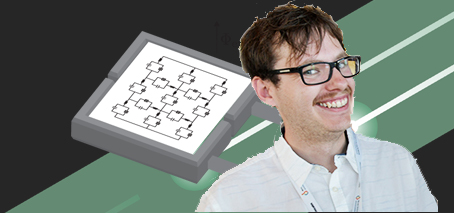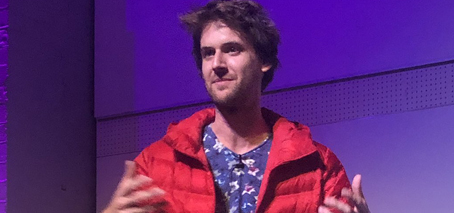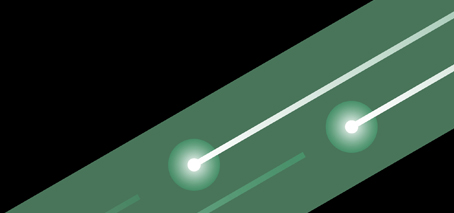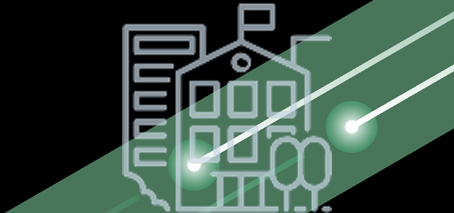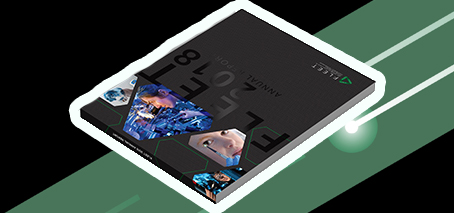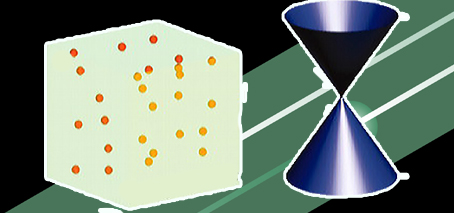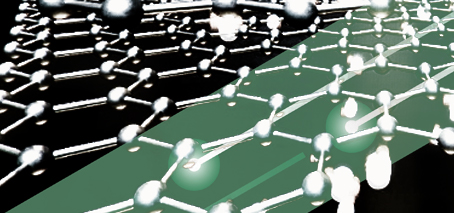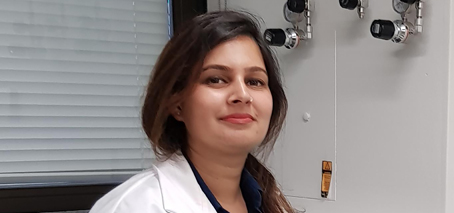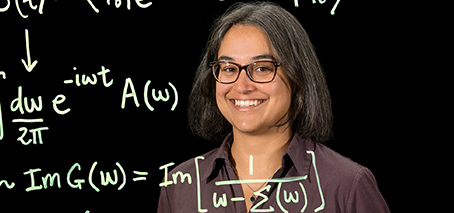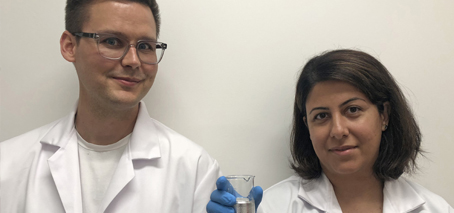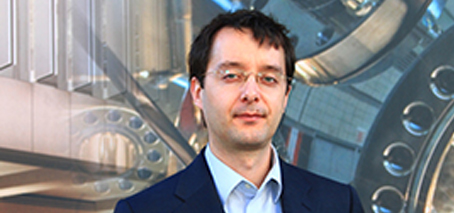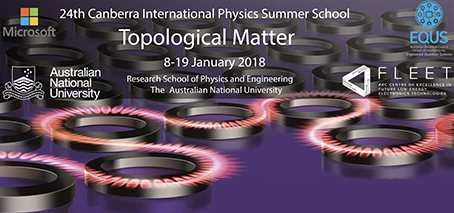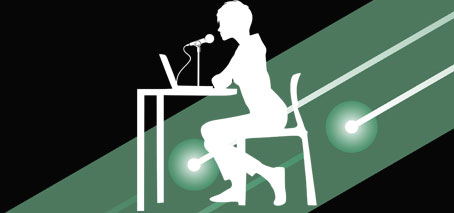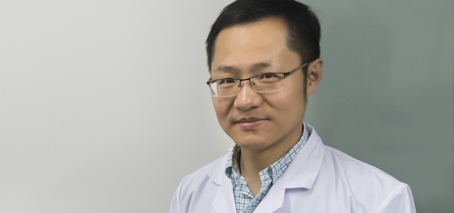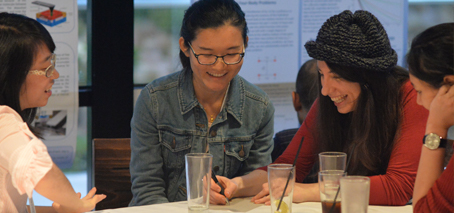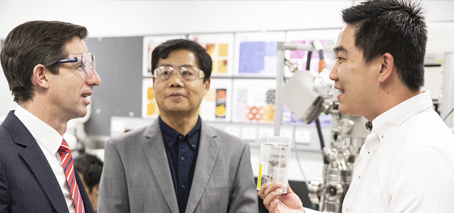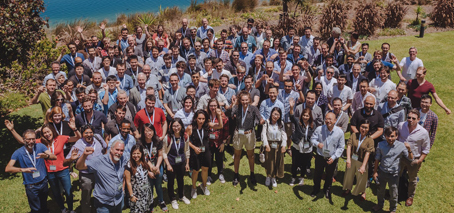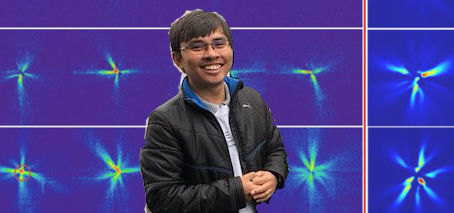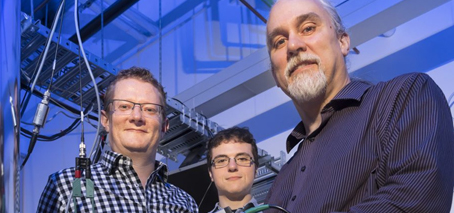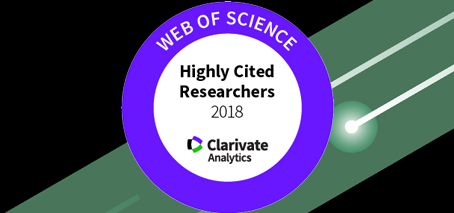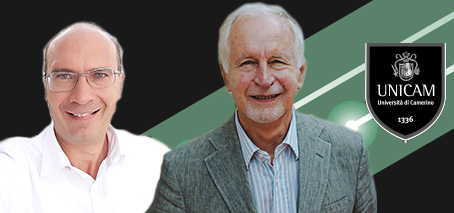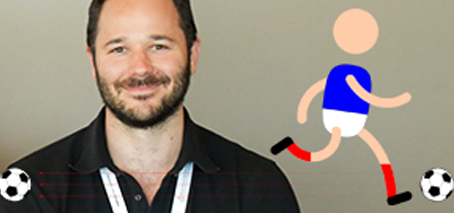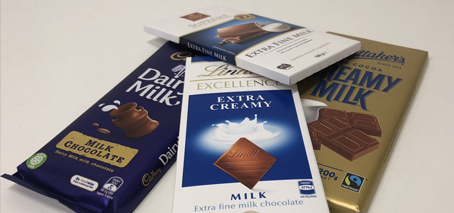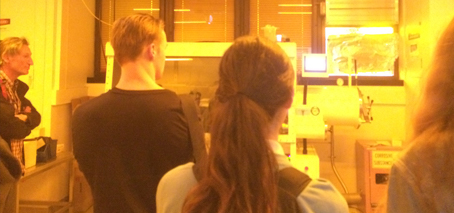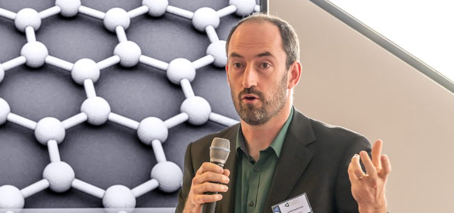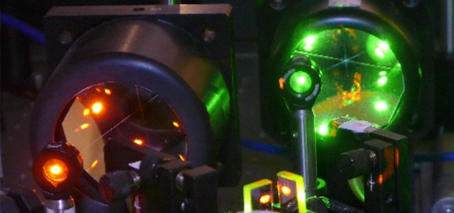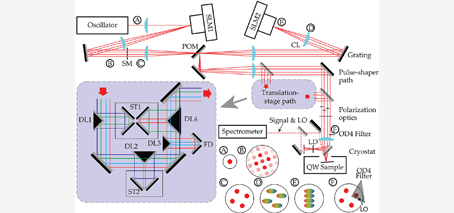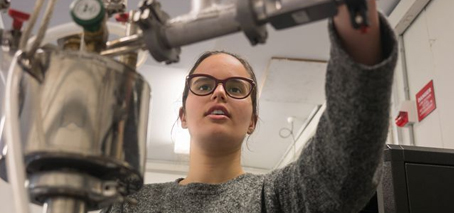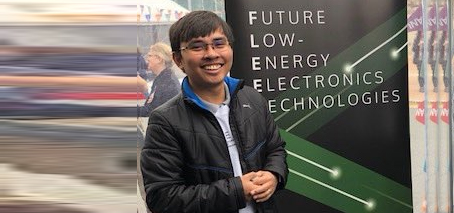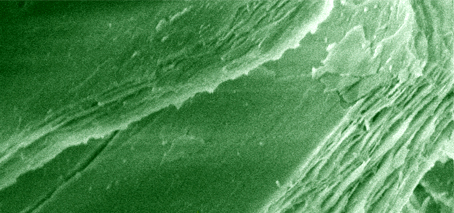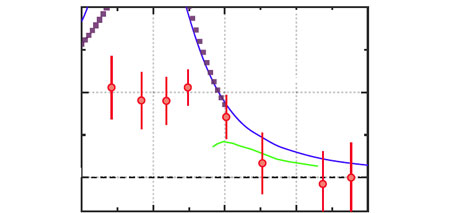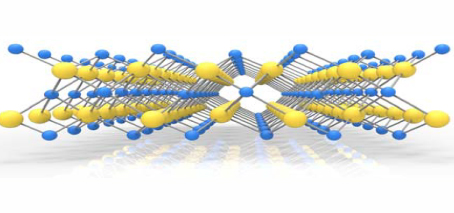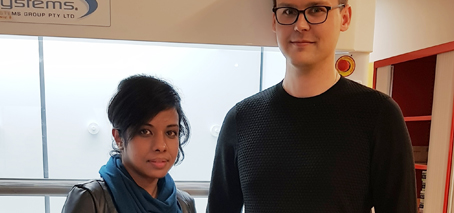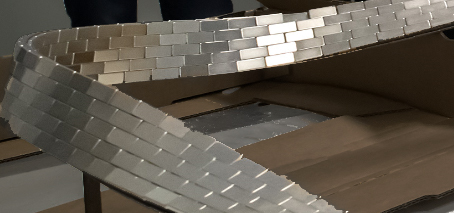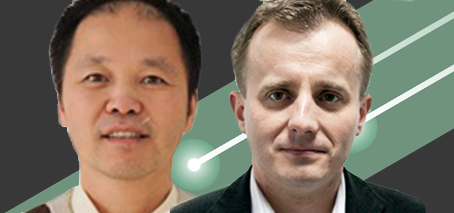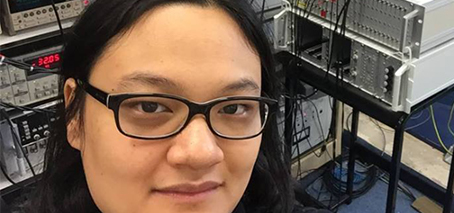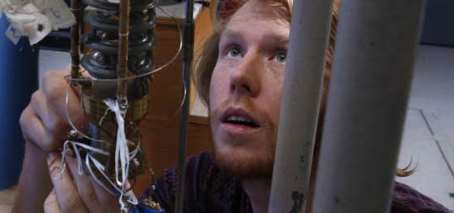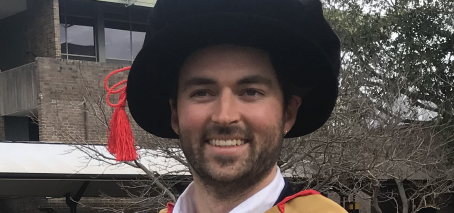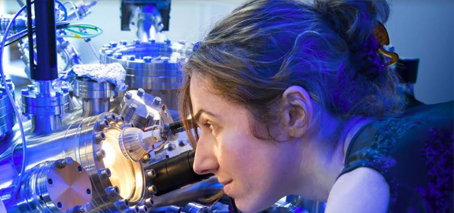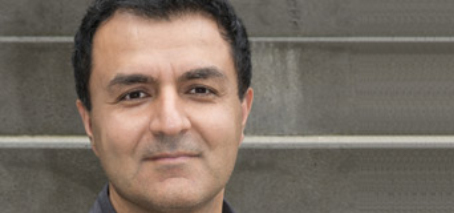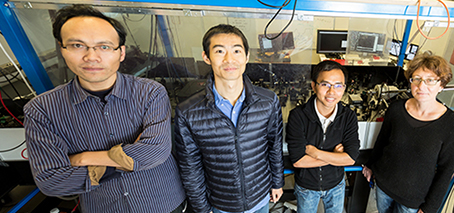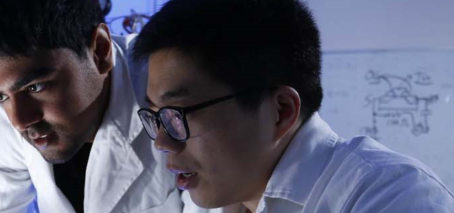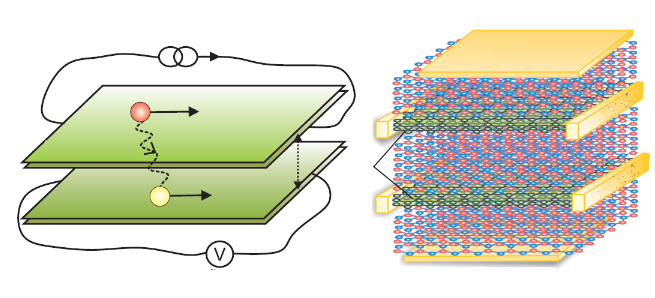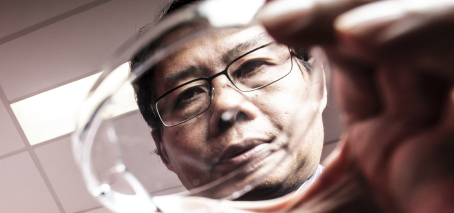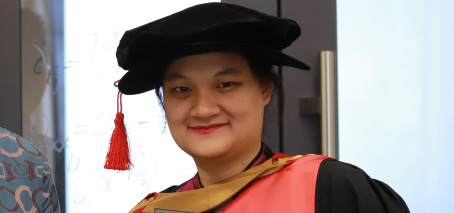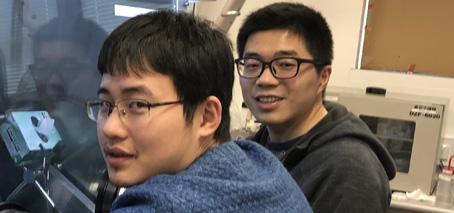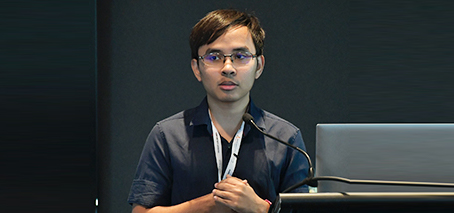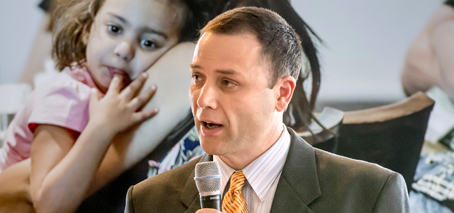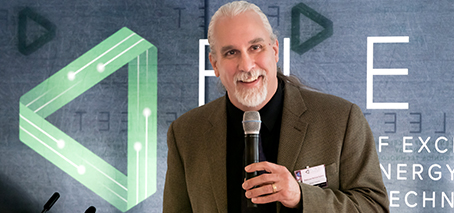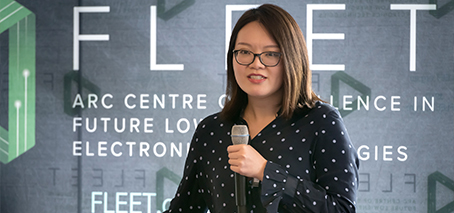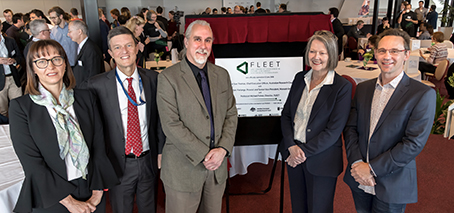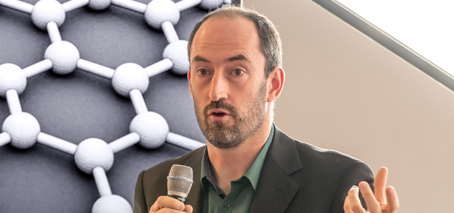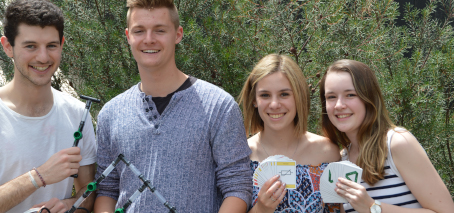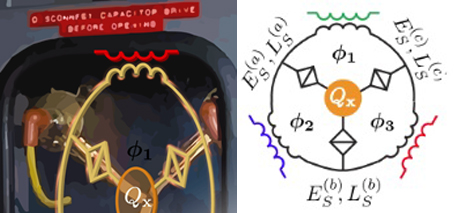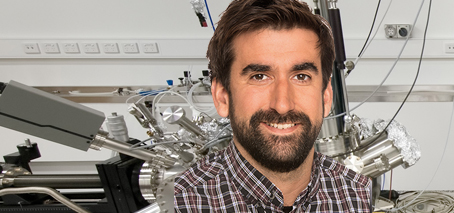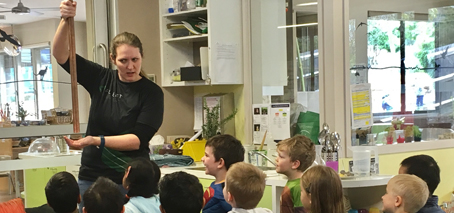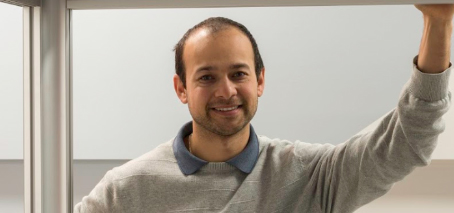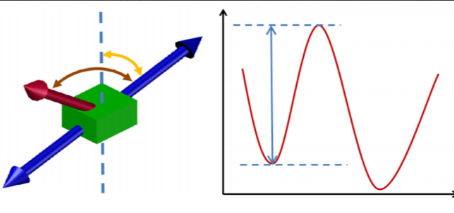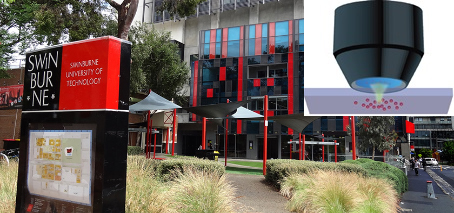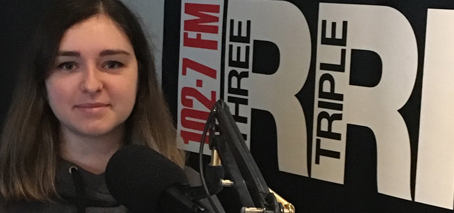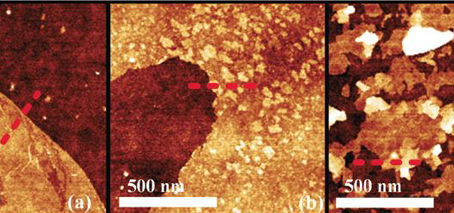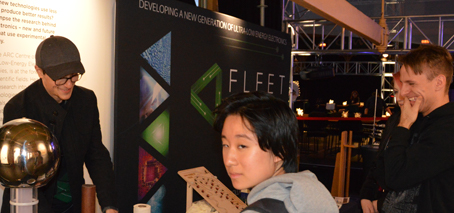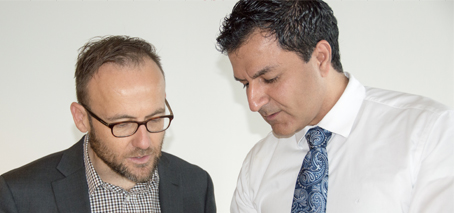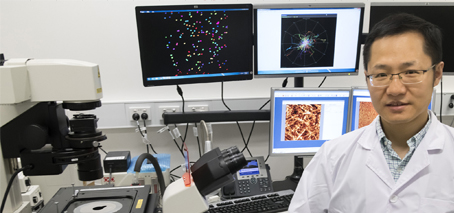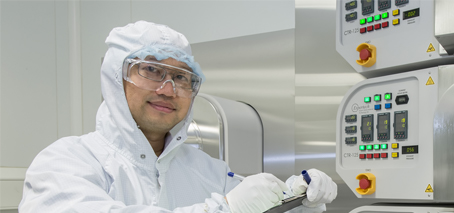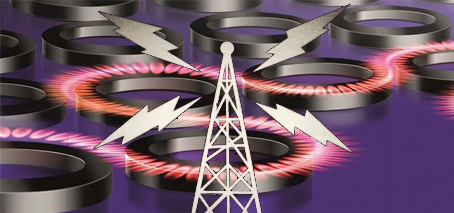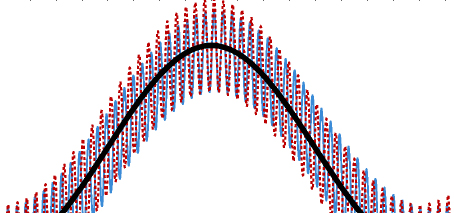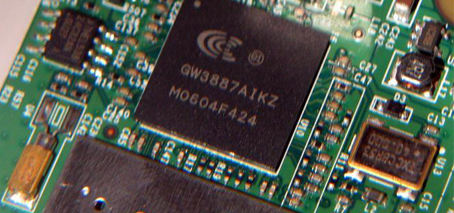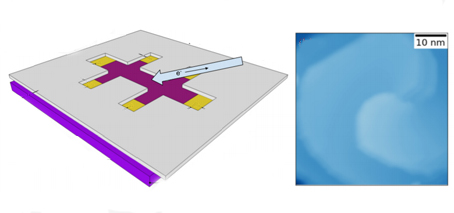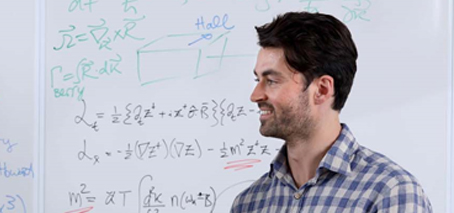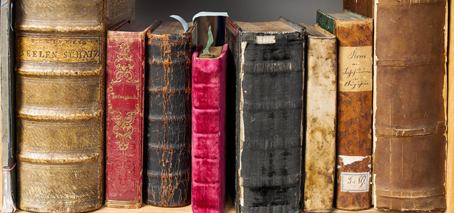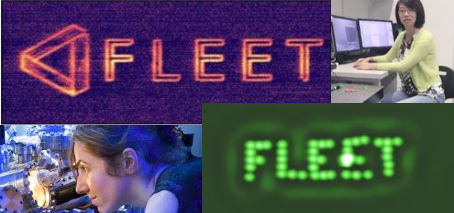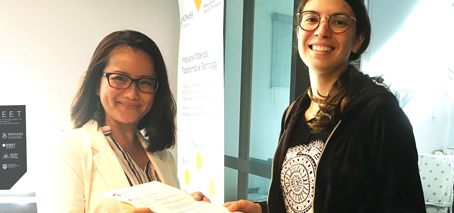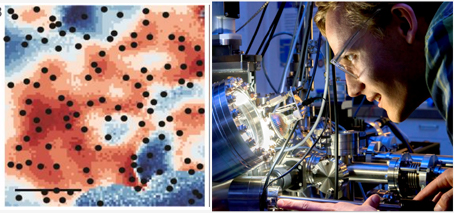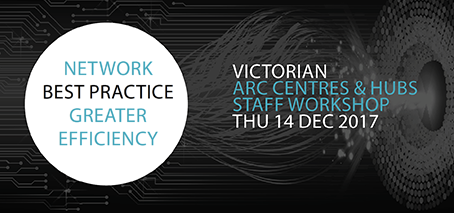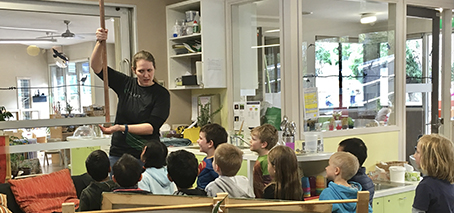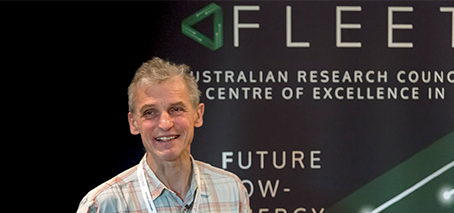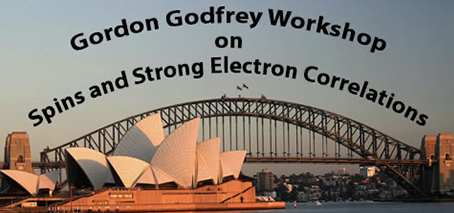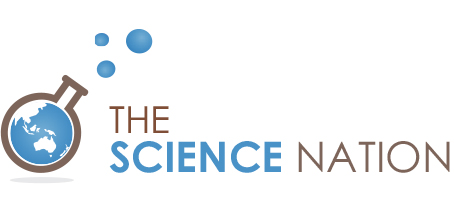The Josephson junction is one of the most important elements in turning quantum phenomena into usable technology. A new RMIT study establishes a theoretical framework for new optical experimentation on these key devices, with implications for future fundamental quantum research and applications such as quantum computing. Josephson junction studies Josephson junctions can be formed by two superconducting plates, separated by …
Topological physics finds Famelab success
Congratulations to FLEET’s Sam Bladwell (right, UNSW), who won the NSW semifinal of Famelab, talking about study of electron spin, and will now compete in the finals in Perth on May 8th. Topological physics has done particularly well in this year’s Famelab, with FLEET associates Dr Semonti Bhattacharyya and Dr Antonija Grubisic-Cabo (Monash University) also qualifying for the Victorian semifinals. …
Welcoming two new Associate Investigators
Dr Dmitry Efimkin (right) is a Scientific Associate Investigator at Monash University specialising in novel materials such as Dirac materials, graphene and topological insulators, and optical phenomena in solids. Within FLEET, Dmitry works with CIs Michael Fuhrer, Meera Parish, and Nikhil Medhekar in Research theme 2: exciton superfluids and Enabling technology A: atomically-thin materials, studying optical and collective phenomena in …
Excellence in Research in Australia: ERA results
FLEET’s member universities performed extremely well in recently announced ERA results, looking at the fields of research in which the Centre is active. The ARC’s audit found that in: Physics, every Centre node ranked in the highest possible ranking Engineering, all nodes ranked above (or well above) world standard Materials engineering, fives nodes ranked in the highest ranking Technology, five …
Welcome new FLEET crew members
We have recently welcomed a number of new Centre members, including: New PhD students (in most cases, having decided to continue with us after their FLEET Honours projects): Bernard Field with Agustin Schiffrin (Monash) Oliver Stockdale with Matt Davis (UQ) Yik-Kheng Lee with Jared Cole (RMIT) Zeb Krix with Oleg Sushkov (UNSW) Mitchell Conway with Jeff Davis (Swinburne) Lina Sang with Xiaolin Wang (UOW) New …
Read FLEET’s latest annual report
We’re pleased to present hot-off-the-press FLEET ‘s 2018 Annual Report. 2018 marked the first full year of research operations at FLEET and we’d love to share the Centre’s research efforts with you in this second annual report. The web-friendly version is also available for download… For detailed lists of the centre organised events and media outputs etc, please view the 2018 Report …
FLEET collaboration reviews ferromagnetism in 2D materials
* Two-dimensional magnetism reviewed in new, collaborative review A collaborative FLEET study has reviewed recent progress in 2D ferromagnetism, and predict new, possible 2D ferromagnetic materials. The study also introduces possible applications of atomically-thin ferromagnets in novel dissipationless electronics, spintronics, and other conventional magnetic technologies. The scientists propose a new method of observing 2D ferromagnetism that could reveal new materials. …
I can’t believe it’s not graphene: nanoengineering artificial graphene
New facility improves study of ‘artificial graphene’ at FLEET ‘Like driving a new Maserati!’ The amazing electrical properties of graphene and other 2D, atomically-thin crystals are due to the symmetry of their lattice structure. For example, it is graphene’s famous ‘honeycomb’ lattice that causes electrons to act as they were massless – moving about 70 times faster than in silicon …
Three young FLEET scientists off to Lindau Nobel meeting
Three FLEET researchers have been chosen to represent Australia at the annual Lindau Nobel Laureate Meeting this year. The three FLEET researchers will among ten early-career Australian scientists attending the 69th Meeting of Nobel Laureates in Lindau, Germany, 30 June – 5 July 2019. The 69th Lindau Nobel Laureate Meeting will be dedicated to physics. To date, 42 Nobel Laureates have …
Women in FLEET Fellowships
In the Centre’s first two years, FLEET’s recruitment had drawn from the existing physics pool, which (along with related fields such as engineering and material science) unfortunately features a relatively low percentage of women. Women in FLEET Fellowships were conceived as a way to allow the Centre to begin to increase the percentage of women above the average in these …
Meera Parish named APS 2019 Outstanding Referee
FLEET’s Meera Parish has been named 2019 Outstanding Referee, the only one in Australia, by the influential American Physical Society (APS). The APS selected 143 Outstanding Referees for 2019, each of whom have demonstrated exceptional work in the assessment of manuscripts submitted to the Physical Review journals. The Outstanding Referee program recognises approximately 150 currently active referees each year, and …
Climate rewind: Scientists turn carbon dioxide back into coal
Researchers have used liquid metals to turn carbon dioxide back into solid coal, in a world-first breakthrough that could transform our approach to carbon capture and storage. The research team led by RMIT University in Melbourne, Australia, have developed a new technique that can efficiently convert CO2 from a gas into solid particles of carbon. Published in the journal Nature …
Topological defects could be key to future nano-electronics
• Ferroic and multiferroic topological structures offer exciting potential in future nanoelectronics • Commentary piece published this week in Nature Materials The connection from fridge magnets to cutting edge materials science is shorter than what one might expect. The reason why a magnet sticks to your fridge is that electronic spins or magnetic moments in the magnetic material spontaneously align …
Networking and skills development: Canberra Summer School
Recognising the increasing importance of topological physics, FLEET helped run the 2018 Canberra International Physics Summer School on Topological Matter at ANU – a great opportunity for early-career Australian physicists to hear from leading experts from around the world. Over 90 attendees discovered topological materials’ applications to photonics, ultra-cold systems and quantum computation. Nobel laureate Prof Duncan Haldane (Princeton University) …
Pitch perfect: 2018 Idea Factory
In 2018, FLEET began an ongoing partnership with the ARC Centre for Engineered Quantum Systems (EQUS) to run a yearly ECR workshop building skills in communication, methods for pitching and presenting science, and working collaboratively with others. In between the teams’ pitch preparation and delivery, formal training sessions included science communication, oral presentations and how to craft an engaging research …
Expanded partnership with Tsinghua University: meet FLEET’s two new Partner Investigators
FLEET’s fruitful relationship with Tsinghua University (Beijing) has been expanded, with the Centre welcoming two new Partner Investigators to lead research collaborations. Prof Shuyun Zhou studies the electronic structure of novel two-dimensional materials and heterostructures using advanced electron spectroscopic tools, including angle-resolved photoemission spectroscopy (ARPES), spin-resolved ARPES, nano-ARPES and ultrafast, time-resolved ARPES. She has made important progress on the electronic structure …
Monash engineers unlock avenue for early cancer diagnosis
Monash University engineers have unlocked the door to earlier detection of cancer with a world-first study identifying a potential new testing method that could save millions of lives. Researchers found that a sensor using new, more sensitive materials to look for key markers of disease in the body increased detection by up to 10,000 times. Associate Professor Qiaoliang Bao from …
Learning to tell their science story: ECR comms training
Communications workshop for early-career researchers and PhD students Success in science requires the ability to describe one’s research in a coherent and compelling manner. FLEET has made an early start in building these skills in ECRs, with a half-day training session targeting science communications skills. A professional external facilitator from consultancy Mind Your Way coached young researchers on the particular …
Live-streamed FLEET seminars
In 2018 FLEET began a series of live-streamed seminars to help share research results across the Centre, keep members informed on latest FLEET research, and enhance inter-node collaboration. Early-career researchers presenting the seminars gain valuable presentation experience, and benefit from feedback on their research from diverse Centre members. These seminars also provide an opportunity for regular get-togethers in each node, …
Engaging with policymakers in 2018
Education Minister Simon Birmingham and ARC CEO Sue Thomas visited FLEET labs in may this year at the University of Wollongong’s (UOW’s) Innovation Campus. UOW node leader Prof Xiaolin Wang, Centre Deputy Director Prof Alex Hamilton (UNSW) and UOW researchers gave the Minister a quick introduction to ICT energy-use issues, topological insulators and atomically-thin materials, including a tour of labs …
FLEET’s first annual workshop: member engagement
Forging a Centre that is greater than the sum of its parts FLEET’s inaugural annual workshop in Torquay, Victoria, represented the Centre’s first chance to cement relationships between geographically-isolated research nodes and diverse physics disciplines. With a focus on education, each day began with a tutorial laying out the fundamentals for one of three research themes. This introduction maximised the …
Centre hosts major international 2D conference: ICON2DMat
FLEET hosted the International Conference on Two-Dimensional Materials and Technologies (ICON-2DMat) in Melbourne in December 2018. This was the first time ICON-2DMat had been held in Australia, and with around 300 international and Australian delegates attending, it was an opportunity to showcase the strength of atomically-thin materials research in Australia. Attendance at the international conferences on 2D materials is growing, …
Building a cohesive Centre: 2018 annual workshop
Forging a Centre that is greater than the sum of its parts FLEET’s second annual workshop built on the successes of the 2017 workshop, bringing all of the Centre’s members and many international partners together in Magenta, mid-coast New South Wales. As in 2017, the workshop was family friendly, with partners and family made welcome at shared meals, social events …
First snapshot of exciton-polariton condensation process
First snapshot of exciton-polariton Bose-Einstein condensation (BEC) in an inorganic semiconductor Unique opportunity to understand details of BEC without statistical averaging Key to fundamental understanding of exciton-polaritons An ANU advance provides never-before-achieved ‘snapshot’ of Bose-Einstein condensation. Previously, observations of exciton-polaritons in a Bose-Einstein condensate were limited to statistical averaging over millions of condensation events. ‘Snapshot’ imaging of polaritons forming a …
Topological material switched off and on for the first time: key advance for future topological transistors
Significant step toward future topological electronics The first electric field-switchable topological material Topological transistors would be an ultra-low energy , beyond CMOS solution to ICT energy use after the end of Moore’s Law Over the last decade, there has been much excitement about the discovery, recognised by the Nobel Prize in Physics only two years ago, that there are two …
Three FLEET researchers in Clarivate highly-cited researchers list for 2018
Congratulations to: Michael Fuhrer (Monash University) in the fields of Materials Science; Physics Kourosh Kalantar-zadeh (UNSW and RMIT) in Chemistry; Engineering Qiaoliang Bao (Monash University) in Materials Science; Optics; Physics. The Clarivate Analytics list identifies researchers ranking in the top 1% by citations for their field. Now in its fifth year, the citation identifies influential researchers as determined by their …
New Australia–Italy collaboration: FLEET partners with University of Camerino
FLEET is pleased to announce a new partnership with the University of Camerino (Italy), which will exploit strengths of both groups in the study of exciton superfluids. The University’s Professor Andrea Perali and Professor David Neilson join FLEET as new Partner Investigators. Professors Perali and Neilson study the theory of of exciton superfluids,and since 2012 have collaborated with FLEET’s Deputy …
Clarifying effects of negative mass
A FLEET study led by University of Queensland’s David Colas clarifies recent studies of negative mass, investigating the strange phenomenon of self-interference. Negative mass?? When we think of ‘mass’, we usually consider the ‘inertial’ mass – the resistance of a body to acceleration due to an applied force. For a moving object, its mass is then a simple relationship between …
Topological insulators are like a block of chocolates
Electrically, topological insulators resemble a chocolate block wrapped in foil: electrically insulating on the inside (the chocolate), but electrically conductive around the edges (the foil). It’s a very useful analogy to describe a new type of material, but we decided to test whether it’s actually correct. We tested four bars of chocolate, measuring the electrical resistance of the surrounding foil, …
FLEET Director Michael Fuhrer in sustainable material-science event, NZ
Michael Fuhrer spoke last month at the NZ sustainable material-science event, Materialise, an event that saw significant coverage in NZ mainstream and science media. FLEET collaborators the MacDiarmid Institute organised the event, and surrounding coverage featured: an online game featuring a micro-sized Michael Fuhrer radio interview with MacDiarmid’s Nicola Gaston NZ Herald article re sustainable energy research, ultra low energy …
Researchers discover directional, long-lived nanolight in 2D material
An international team led by researchers from Soochow University (Suzhou, China), Monash University (Melbourne, Australia), University of Oviedo (Asturias, Spain), and CIC nanoGUNE (San Sebastián, Spain) have discovered squeezed light (‘nanolight’) in the nanoscale that propagates only in specific directions along thin slabs of molybdenum trioxide – a natural anisotropic 2D material. Besides its unique directional character, this nanolight lives …
Physicists tour FLEET-RMIT
FLEET’s RMIT labs recently hosted a tour by members of the Victorian branch of the Australian Institute of Physics, the country’s leading body for physics advocacy and support. The tour included the experimental laboratories and a briefing by RMIT node leader Prof Lan Wang, and AI Torben Daeneke, covering the research topics in Lan Wang’s group, Jared Cole’s group, JianZhen …
Congratulations Jared Cole CI
Congratulations to RMIT Professor Jared Cole, now a FLEET Chief Investigator. Jared is a theoretical physicist specialising in quantum physics and decoherence theory, particularly its application to solid-state systems. Within FLEET Jared investigates the influence of dissipation and decoherence on electronic transport in nanostructures, and its role in electronic devices based on topologically protected conduction channels. This is key to …
Nobel-winning science is key to Australian research: ultra-fast laser physics
Half of the 2018 Nobel Prize for Physics has been awarded to Gérard Mourou and Donna Strickland for their method of generating high-intensity, ultra-short optical pulses Ultra-fast laser physics key to development of future electronics The technique developed by Mourou and Strickland has had enormous impact across the fields of chemistry, physics and biology, and provides the basis for important …
Laser pulses quadrillionths of a second long probe electronic structure at Swinburne
Quantifying the dynamics and interactions of electronic systems is crucial for understanding the mechanisms that make them useful candidates for ultra-low energy electronics. We need to observe and measure the behaviour of electron interactions at a femtosecond scale (ie, at a few millionths of a billionth of a second). As a research tool, Optical Coherent Multidimensional Spectroscopy (CMDS) offers the …
First year physics students exploring future electronics
First year physics students enthusiastic to explore ‘new’ physics Measuring quantum Hall effect with liquid helium-3, a Cold War side-product Window to topological materials and future electronics UNSW first year physics students have been measuring the quantum Hall effect (QHE), a relatively new piece of physics recognised by the 1985 Nobel Prize in Physics, which requires precision experimental setup. When …
FLEET collaboration aims to prevent energy losing its way
Published in Monash Lens 27 Sep 2018 Featuring Meera Parish & Michael Fuhrer, School of Physics & Astronomy, Monash University Cheaper, faster, smarter, smaller – the ever-evolving digital world has changed the way we live, as predicted by the law Gordon Moore outlined in 1965. Moore’s Law foretold that the number of transistors in a dense integrated circuit would double …
Polaritons and the thrill of fundamental discoveries: meet FLEET’s Eliezer Estrecho
FLEET’s Eli Estrecho recently finished his PhD, and is now a postdoctoral researcher, working with Professor Elena Ostrovskaya in the Polariton-BEC Research Group, Australian National University. We asked Eli some questions about his research, how he got into physics, and the thrill of fundamental discoveries. Q: Tell me about your research at ANU EE: I study hybrid particles of light …
Quick and not-so-dirty: a rapid nano-filter for clean water
FLEET researchers have designed a rapid nano-filter that can clean dirty water over 100 times faster than current technology. Simple to make and simple to scale up, the technology harnesses naturally occurring nano-structures of aluminium hydroxide that grow on liquid metal gallium. The researchers behind the innovation at RMIT University and UNSW have shown it can filter both heavy metals …
Quantum anomaly – breaking a classical symmetry with ultracold atoms
Scaling symmetry in a 2D Fermi gas breaks down with strong interactions between particles Quantum gas studies unlock fundamental physics—with an immediate application A FLEET study of ultracold atomic gases – a billionth the temperature of outer space – unlocks new, fundamental quantum effects. The researchers at Swinburne University of Technology studied collective oscillations in ultracold atomic gases – identifying …
Ferroelectric switching in Indium(III) selenide: potential for ultra-low energy electronics
The discovery of new ferroelectric properties in the novel, layered material Indium(III) selenide (β’-In2Se3) enhances this material’s candidacy for non-volatile memory and low-power electronic and optoelectronic switches. FLEET researchers at Monash University and UNSW were on the Australian-Chinese team that confirmed in-plane ferroelectricity in the material, β’-phase In2Se3. In2Se3 belongs to a class of layered materials known as van der Waals …
Pushing ‘print’ on large-scale piezoelectric materials
First ever large-scale 2D surface deposition of piezoelectric material Simple, inexpensive technique opens new fields for piezo-sensors & energy harvesting Researchers have developed a revolutionary method to ‘print’ large-scale sheets of two dimensional piezoelectric material, opening new opportunities for piezo-sensors and energy harvesting. Importantly, the inexpensive process allows the integration of piezoelectric components directly onto silicon chips. Until now, no …
Supercool, superconducting Mobius track helps communicate FLEET science
A super-cooled, superconducting Mobius-track impresses the crowds, helps embed FLEET science As a cool science demo, FLEET’s superconductor Mobius track ticks all the boxes: liquid nitrogen – tick. Superconductor – tick. Cool shape – tick. Relevance to the science – tick tick tick. The track features 1500 neodymium magnets, fixed into the shape of a Mobius strip, so that a …
New FLEET partnerships with Beijing and Wroclaw
We are extremely pleased to announce two new FLEET partners. The Beijing Computational Science Research Center (CSRC) and Wroclaw University of Science and Technology have joined the 13 other leading Australian and international science organisations partnering with FLEET. Wroclaw University of Science and Technology (WUST) is Poland’s top-ranked new-technology university, excelling in computer science, electronics and materials science. Our new Partner …
Putting a New Spin to the Hole Story
Controlling hole spin for future quantum spin-based devices, topological materials The ‘spins’ of electrons (and holes) in semiconductors have potential applications in spintronics, spin-based quantum computing, and topological systems. A particle’s spin is its intrinsic angular momentum. In a magnetic field, the spins of electrons or holes becomes oriented either parallel (‘spin-up’) or anti-parallel (‘spin-down’) to the field direction – just …
Building artificial atoms using holes
Hole-based artificial atoms could be key to spin-based qubit First isolation of one individual hole in a silicon MOSFET quantum dot A UNSW study published this week resolves key challenges in creation of hole-based artificial atoms, with excellent potential for more-stable, faster, more scalable quantum computing. Artificial atoms in quantum computing The spin states of electrons confined to semiconductor quantum …
Congratulations Harley Scammell: PhD recognised
Exciting new states of quantum matter enlisted to important environmental challenges FLEET’s Harley Scammell’s outstanding PhD recognised by UNSW The thesis “Interplay of quantum and statistical fluctuations in critical quantum matter” will be published by Springer in hardcover and ebook. “It’s really great to have this research recognised by UNSW”, says Harley. “Hopefully, having the thesis published at Springer will make this …
Atomic-scale material engineering, inspired by nature
New materials inspired by nature could be key to future electronics Self-assembled nanostructures have atomically-precise structure and tailored electronic properties Bio organisms are the most-complex machines we know, and are capable of achieving demanding functions with great efficiency. A common theme in these bio-machines is that everything important happens at the level of single molecules – that is, at the …
Congratulations Kourosh Kalantar-Zadeh, ARC Laureate Fellow
Congratulations to FLEET’s Kourosh Kalantar-Zadeh — named an Australian Research Council Laureate Fellow today. Kourosh’s significant influences in engineering include two-dimensional (2D) transition metal compounds, liquid metals, microfluidics, sensors, electronic devices and medical systems. He is an expert in chemical and biochemical sensors, nanotechnology, microsystems, materials science, electronics, gastroenterology, medical devices and microfluidics, and has made internationally-recognised contributions to the …
Chiral flow: twisting exciton-polariton condensates at exceptional points
Outstanding problem in exciton-polariton physics resolved using exceptional points at ANU Chirality of mode at EP opens future research avenues for exciton-polariton physics Researchers at ANU recently proved a novel method for generating orbital angular momentum states (vortices), with a topological charge that is ensured by an exceptional point. Recent studies at the ANU resolve an outstanding problem in exciton-polariton …
Why 2D? Measuring thickness-dependent electronic properties
Why 2D? What is it about two-dimensional materials that makes them so interesting for FLEET? FLEET UNSW/Wollongong collaboration finds transition point from 3D to 2D properties Constraining the movement of charge carriers (electrons or holes) to two dimensions unlocks unusual quantum properties, resulting in useful electronic properties. Although we refer to the layers within such materials as ‘2D’, they are …
Puzzling results explained: a multiband approach to Coulomb drag and indirect excitons
Taking a multiband approach explains ‘electron-hole reverse drag’ and exciton formation Mystifying experimental results obtained independently by two research groups in the USA seemed to show coupled holes and electrons moving in the opposite direction to theory. Now, a new theoretical study has explained the previously mysterious result, by showing that this apparently contradictory phenomenon is associated with the bandgap …
Science fiction becomes science fact as researchers create liquid metal heartbeat
Discovery has potential applications in artificial muscles, soft robotics and microfluidic circuitry In a breakthrough discovery, University of Wollongong (UOW) researchers have created a “heartbeat” effect in liquid metal, causing the metal to pulse rhythmically in a manner similar to a beating heart. Their findings are published in the 11 July issue of Physical Review Letters, the world’s premier journal …
Love of maths leads to spin PhD: Congratulations Dr Elizabeth Marcellina
Maths and spin: key to new electronics A love of maths brought Elizabeth Marcellina to the study of quantum and condensed-matter physics, where her recently completed PhD research studied possible routes to faster, more efficient electronics, by harnessing the ‘spin’ of the carriers in common semiconductors. As Moore’s law is coming to an end, much effort has been devoted to …
Centre collaboration combines material expertise
FLEET RMIT—UNSW collaboration measuring transport properties of van der Waals heterostructures FLEET PhD Cheng Tan (RMIT) visited UNSW’s labs in May to perform magnetic coupling measurements on 2D ferromagnetic crystals. The visit was reciprocated this month with FLEET Research Fellow Feixiang Xiang (UNSW) visiting RMIT to construct van der Waals structures for studying of 2D topological systems. This collaboration between …
Trapping light–matter particles at ANU
FLEET collaboration traps light–matter particles FLEET’s Research theme 2 seeks to create near-zero resistance flow of exciton polaritons, which are hybrid quasi-particles that are part matter and part light. Their ability to flow without resistance relies on formation of an exciton-polariton condensate – a collective quantum state that behaves as a superfluid. In superfluids, particles flow without encountering any resistance …
More than just great science: Matt Davis at the Centre Launch
FLEET will deliver much more than excellent science for Australian society. We are training some of the next generation of scientists, engineers, and entrepreneurs. We will help them develop not only technical research skills, but also transferable skills that will be useful to them no matter what their eventual career direction. For example, we have ensured that our research groups …
FLEET’s challenge and legacy
The challenge of finding a sustainable path to continuing the IT revolution is critical, and time is running out. I can tell you today with reasonable certainty that Moore’s Law will be declared dead within the seven-year operation of the Centre–perhaps even before our mid-term review! Computer chips will cease to gain in efficiency, and yet our demand for computation …
The case for FLEET: 8% of global electricity now consumed by computing
The information technology revolution has improved our lives, and we want it to continue. For example, our smartphone has become one of the most important devices of our everyday life: we use it to access up-to-date weather predictions, to plot the best route through traffic, and to watch the new series of House of Cards. And we expect it be …
Launching low energy electronics: FLEET Launch 12 June
Our insatiable appetite for computing means ITC already consumes 5–8% of global electricity, and is doubling each decade. Unless that ever-growing demand for computing can continue to be met with efficiency gains, the information revolution will slow down from power hunger. At the launch of a new Australian Research Council Centre of Excellence the audience heard that efficiency gains in current, …
Launch of FLEET Centre of Excellence to tackle hidden energy costs of computing
Official launch: Australian Research Council Centre of Excellence in Future Low-Energy Electronics Technologies 12 June 2018, 11 AM New Horizons Building, Monash University, Clayton We have an insatiable appetite for computing. But our ongoing need for computation is burning more than 5 percent of global electricity. And that figure is expected to double each decade. A new Australian Research Council …
The innovative science behind FLEET: Jared Cole at the Centre Launch
When using an electronic device to watch tv, listen to music, model the weather or any other task that requires information to be processes, there are millions and millions of binary calculations going on in the background. There are zeros and ones being flipped, added, multiplied and divided at incredible speeds. The fact that a microprocessor can perform these calculations …
Macro-chips and electronic card games: challenging students
Fresh minds develop hands-on learning methods for schools FLEET is developing innovative ways to communicate physics to school students. A collaboration with Monash University Science allowed the Centre to enlist fresh brains to this communications challenge. A team of maths and physics students from Monash Bachelor of Science–Global Challenges took on the task of developing hands-on games and resources to demonstrate …
Physicists invent flux capacitor, break time-reversal symmetry
In the popular movie franchise “Back to the Future”, an eccentric scientist creates a time machine that runs on a flux capacitor. Now a group of actual physicists from Australia and Switzerland have proposed a device which uses the quantum tunneling of magnetic flux around a capacitor, breaking time-reversal symmetry. The research, published this week in Physical Review Letters, proposes …
Agustin describes atomic-scale materials engineering on RRR
FLEET Chief Investigator Agustin Schiffrin spoke on science show Einstein a Go-Go about experimental physics at the atomic scale, and the study of exciting new nanomaterials with tailored electronic properties. Listen Agustin researches new nanomaterials with novel and exotic electronic properties, constructed of organic (carbon-based) molecules, sometimes inspired by bio-organisms. The team studies topological materials, which display a range of fascinating, …
Sharing a passion for science: outreach to schools
FLEET shares the responsibility to support students and teachers to increase participation in science, and in particular works towards increasing the number of girls and women participating in physics, chemistry and engineering. The Centre Launch on 12 June will showcase FLEET’s science outreach programs, educating the public and inspiring a new generation of scientists. Home Science and FLEET Geeks programs …
Carlos talks ultra-cold atoms and inspiring schoolkids to do science, RRR
FLEET postdoc Dr Carlos Kuhn described his field of ultra-cold atomic science and the fundamental discoveries made in an interview with RRR science show Einstein a Go-Go. The research will take a huge step forward this year with the commissioning of a new ARC-funded quantum-gas microscope, which will bridge the microscopic (atomic) and macroscopic (visible) worlds. Carlos also described his …
Thinner is better: van der Waals (vdW) material shows the right stuff at 200 nanometres
The unusual electronic and magnetic properties of van der Waals (vdW) materials, made up of many ‘stacked’ 2D layers, offer potential for future electronics, including spintronics. In a recent study, FLEET researchers at RMIT found that one promising candidate material, Fe3GeTe2 (FGT), fits the bill – provided it’s created in layers only 200 millionths of a millimetre in thickness. This …
Single-atom manipulation at Swinburne with new, shared quantum-gas microscope
Bridge between microscopic and macroscopic behaviour A new quantum-gas microscope facility at Swinburne University of Technology will allow studies of ultra-cold atomic gases, giving researchers the ability to image and manipulate single atoms. The facility will allow study of quantum effects at a macroscopic scale: a major unsolved issue in physics. To harness the full potential of such quantum materials, …
Rebecca Orrell-Trigg (RMIT) interview re liquid metal and 2D materials, RRR
FLEET PhD student Rebecca Orrell-Trigg (RMIT) uses liquid metals to synthesise 2D (atomically thin) materials for use in future ultra-low energy electronic devices. Late last year they developed a liquid metal “bubbling” method that was described as “ground breaking”, and have since refined this method to make it even more widely applicable. Rebecca’s interview covered the advantages of the new …
Characterising tin-oxide growth: improved understanding of ground-breaking liquid-metal 2D technique
Last year, FLEET researchers at RMIT developed a ground-breaking new method of depositing atomically-thin (two-dimensional) crystals using molten metals, described as a ‘once-in-a-decade’ advance. Earlier this year, the same research team expanded the new method from controlled to ambient conditions, and has properly characterised the growth mechanisms for key tin oxides, which should allow improved control of target oxide growth. …
Building members’ outreach skills: 2018 Melbourne Knowledge Week
Melbourne Knowledge Week (May 2018) was an opportunity for FLEET to engage with the public and road-test a number of outreach demonstrations being developed for schools. It also gave 20 Centre members the opportunity to gain valuable experience in public science outreach, speaking to a diverse audience. Melbourne Knowledge Week showcases cool science and engineering projects in the city of …
Melbourne MP Adam Bandt visiting FLEET RMIT
An MP visit last week provided an opportunity to discuss future electronics, 2D materials and science policy. Melbourne MP and Greens Science/Energy spokesperson Adam Bandt was visiting FLEET’s labs at RMIT, hosted by FLEET RMIT node leader Kourosh Kalantar-Zadeh, and FLEET Director Michael Fuhrer. As well as FLEET researchers, Adam also got to meet our scientific counterparts from the Centre for …
FLEET’s Qiaoliang Bao a champion of Australian nanotech
FLEET-nano collaboration recognised: Congratulations to Qiaoliang Bao, 2018 ANFF-VIC Technology Fellow Qiaoliang Bao works at the nanoscale, trapping photons in atomically-thin, two-dimensional materials, where high binding energies create a quantum state known as a superfluid. The aim is a new generation of superfluid transistors that will ‘switch’ using much less energy than conventional electronics. Such work requires access to the …
Custom, nanoscale structures on demand at RMIT
“Endless” possibilities for custom nanotech design FLEET’s research to achieve zero-dissipation electrical current depends on the design of key nanoscale structures. Within FLEET, nano-device fabrication is coordinated via Enabling technology B, which links each of the research themes. In 2017, Theme B leader Lan Wang, and PhD student Cheng Tan, developed a method to build such nanoscale structures, required to achieve zero-dissipation …
Torben talks liquid metal with Subatomic, Radio Adelaide
“It’s so simple my retired parents could do this in their kitchen.” FLEET AI Torben Daeneke discussed deceptively-simple methods of depositing atomically-thin materials with Rohan Neagle, on Radio Adelaide’s Subatomic radio show. Torben’s interview also covered why 2D materials are key to ultra-low energy electronics, the mechanics of 2D deposition, the end of Moore’s Law and the massive amount of …
Interactions within quantum batteries are key to their charge advantage
Recent theoretical studies at Monash University bring us a step closer to realistic ‘quantum batteries’. Such technology would depend on the energy difference offered by different quantum states, rather than on electrochemical changes, as is the case in traditional batteries. Quantum batteries also offer potential for vastly better thermodynamic efficiency, and ultra-fast charging time. The study, which was co-led by …
Explainer: zeroes and ones and the transistors at the heart of computing
Wait. What do you mean ‘transistors’? Yep, ‘transistors’ are still the basis of electronics. In essence, they’re the tiny controllable switches that form the building blocks of logic circuits, switching between open (0) and closed (1). In your Dad’s old ‘wireless’ radio, transistors were the small metallic components shaped like War of the Worlds war tripods. Those replaced the glass …
Switching conduction mode: a step towards topological transistors
Applying an electric field switches conduction mode of a topological material FLEET researchers achieved a significant landmark in the search for a functional topological transistor in 2017, using an applied electric field to switch the electronic conduction mode of a topological material. A ‘gate’ electrode was used to switch the conduction mode in the topological material Na3Bi. Na3Bi is a …
FLEET postdoc: Fulbright Scholarship to fund superconductivity research at Harvard
Congratulations to FLEET UNSW postdoc Harley Scammell who has been awarded a Fulbright Scholarship to work with world-renowned theoretical physicist Subir Sachdev at Harvard University on the mechanisms behind superconductivity – an exotic quantum phase of matter. The Australian-American Fulbright Commission promotes education and cultural exchange between Australia and the US, By the completion of the Fulbright program, researchers around …
Explainer: Glossary of terms
Some terms and materials relevant to FLEET. The first sentence or two of each definition is aimed at non-physicists. For physicists in the field, these are suggested as accurate, non-jargon simplifications to help communicate your science. More information for experts is given in italics for some terms, as well as useful links. 2D Two-dimensional materials are a single layer of atoms …
Micro branding: creating microscale and nanoscale FLEET banners
FLEET researchers taking an innovative, even ‘playful’, approach to their science have created a couple of unique and interesting branding displays for the Centre. >>>FLEET PhD student Fan Ji developed this micro-sized logo (right) at UNSW. The FLEET logo is etched onto the two-dimensional interface between two materials, in letters only a few thousandths of a millimetre high, using bias-assisted …
First Women in FLEET scholarship recipient
“I love working in FLEET because it challenges me all the time, and because it has deepened my understanding in an essential topic to the progress of technology. I thought I would never be capable to work in an environment full of such brilliant minds.” Jessica Alves at Monash University Engineering is the recipient of FLEET’s first Women in FLEET …
Michael Fuhrer talks more-accessible physics and better transistors on radio 2CC
FLEET Director Michael Fuhrer spoke Friday with ABC Radio 2CC Canberra’s Rod Henshaw about making physics more accessible, and FLEET’s search for better, ultra-low-energy transistors. Listen Prof Fuhrer was in Canberra for the International Physics Summer School on Topological Matter at ANU. Fuhrer discussed energy use in information and communications technology (ICT) and the alternatives that FLEET is pursuing, …
Electronically-smooth ‘3D graphene’: a bright future for trisodium bismuthide
Electronically-smooth nature of trisodium bismuthide makes it a viable alternative to graphene/h-BN Researchers have found that the topological material trisodium bismuthide (Na3Bi) can be manufactured to be as ‘electronically smooth’ as the highest-quality graphene-based alternative, while maintaining graphene’s high electron mobility. Na3Bi is a Topological Dirac Semimetal (TDS), considered a 3D equivalent of graphene in that it shows the same …
Research centres share best practice
Sharing best practice, finding efficiencies, setting up future networks – and swapping a few war stories Operations staff from 18 ARC-funded centres met in Melbourne last week to share best practice and learnings, and to develop future networks among similar roles. How do centres become ‘greater than the sum of the parts’? What strategies have professional staff found to enhance …
Launching FLEET Geeks: taking science to schools
Reaching schoolkids, and setting scientists up for outreach success Bringing practising scientists to schools brings enormous benefits. The FLEET Geeks program sees FLEET members performing science shows at primary schools and kindergartens, demonstrating physics with equipment not typically available to students. The program brings scientists to the students, allowing them to ask questions about scientific phenomena seen in the show, …
Ultracold science and benefits of a changeable career in science: Wolfgang Ketterle
Physics experiments at temperatures a billionth of outer space, and the benefits of flexibility in a science career. Nobel physics laureate Prof Wolfgang Ketterle told a crowd of around 200 at Swinburne University of Technology last week about Bose-Einstein condensates (BECs), and other strange states of matter that exist at nano-Kelvin temperatures, which open a new door to the quantum …
Gordon Godfrey Workshop sparks spin & electron-correlation discussion at UNSW
Over 80 Australian and international physicists met at UNSW last month to discuss spin and strong-electron correlations in the university’s biennial Gordon Godfrey Workshop, including a very strong FLEET contingent. Leading international speakers came from as far afield as China, Denmark, France, Germany, Israel, Italy, Japan, Switzerland, Russia and USA, including Prof David Neilson (University of Camerino), a pioneer of electron-hole exciton …
Science Says! and other outreach collaborations
FLEET supported the first Melbourne show of Science Says!, a science entertainment event run by The Science Nation, with FLEET’s A/Prof Meera Parish (Monash University) and Prof Chris Vale (Swinburne University of Technology) appearing on the panel at the Royal Society of Victoria. FLEET collaborated with Swinburne University of Technology, Monash University School of Physics and Astronomy, and the Australian …

